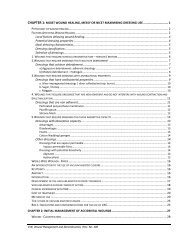permethrin intoxication of cats bibliography - Centre for Veterinary ...
permethrin intoxication of cats bibliography - Centre for Veterinary ...
permethrin intoxication of cats bibliography - Centre for Veterinary ...
You also want an ePaper? Increase the reach of your titles
YUMPU automatically turns print PDFs into web optimized ePapers that Google loves.
CITATION YEAR COUNTRY<br />
<strong>of</strong><br />
AUTHOR<br />
Gfeller, R. W. and S. P. Messonnier (2004).<br />
Handbook <strong>of</strong> small animal toxicology and poisoning.<br />
St Louis, Mosby.<br />
Gleadhill, A. (2004). "Permethrin toxicity in <strong>cats</strong>."<br />
<strong>Veterinary</strong> Record 155(20): 648.<br />
Gray, A. (2000). "Permethrin toxicity in <strong>cats</strong>."<br />
<strong>Veterinary</strong> Record 147(19): 556-556.<br />
Gray, A. (2001). "Permethrin toxicity in <strong>cats</strong> following<br />
use <strong>of</strong> canine <strong>permethrin</strong> spot-on products."<br />
<strong>Veterinary</strong> Record 149(21): 660.<br />
Hall, K. (2008). Toxin exposures and treatments: a<br />
survey <strong>of</strong> practicing veterinarians. Kirk's current<br />
veterinary therapy XIV. J. D. Bonagura and D. C.<br />
Twedt. Philadelphia, Pa, Elsevier Saunders: 95-99.<br />
Hansen, S. R. (1995). Management <strong>of</strong> adverse<br />
reactions to pyrethrin and pyrethroid insecticides.<br />
Kirk's Current <strong>Veterinary</strong> Therapy XII Small Animal<br />
Practice. J. D. Bonagura. Philadelphia, W. B.<br />
Saunders Company: 242-245.<br />
Hansen, S. R. (2001). Pyrethrins and pyrethroids.<br />
Small animal toxicology. M. E. Peterson and P. A.<br />
Talcott. Philadelphia :, Saunders: 687-694.<br />
NOTES<br />
2004 USA<br />
over-the-counter medications are fairly safe, the potential <strong>for</strong> toxic episodes exists due<br />
in large part simply on account <strong>of</strong> the amounts curious unsupervised animals may<br />
ingest. Another part <strong>of</strong> the problem is that since they are over the counter a large<br />
proportion <strong>of</strong> the public perceives them as totally harmless. In this article, we will<br />
investigate the most frequently seen non-prescription <strong>intoxication</strong>s, their mechanism <strong>of</strong><br />
action, clinical signs, diagnosis management, and prevention.<br />
Pyrethrins/pyrethroids, pp282-286<br />
2004 UK<br />
2000 UK<br />
2001 UK<br />
2008 USA The results <strong>of</strong> a survey <strong>of</strong> veterinarians on common small animal toxin exposures and<br />
treatments conducted by the University <strong>of</strong> Minnesota and the <strong>Veterinary</strong> In<strong>for</strong>mation<br />
Network is presented. In response to the question "the five most common toxin<br />
exposures in CATS that present to my practice are", 86% or respondents listed<br />
pyrethrin/<strong>permethrin</strong>. Other exposures listed in decreaseing rank order were plant<br />
<strong>intoxication</strong> (66%), ethylene glycol (47%), acetaminophen (42%), animal envenomation<br />
(40%), NSAIDs (39%), human prescription medication (34%), anticoagulant<br />
rodenticides (27%), and cholinesterase inhibitors (9%). In response to the question<br />
"the five most common toxin exposures in DOGS that present to my practice are" the<br />
following rank order <strong>of</strong> exposures was collected: anticoagulant rodenticides (89% <strong>of</strong><br />
respondents), chocolate (54%), animal envenomation (51%), NSAIDs (45%), human<br />
prescription medication (45%), ethylene glycol (32%), plant <strong>intoxication</strong> (22%),<br />
pyrethrin/<strong>permethrin</strong> (22%), drugs <strong>of</strong> abuse (eg marijuana, cocaine) (18%) and<br />
metaldehyde (snail bait) (16%).<br />
1995 USA No mention that <strong>cats</strong> are especially sensitive to <strong>permethrin</strong> or other SPs.<br />
"Overapplication <strong>of</strong> products on <strong>cats</strong> is more likely to result in adverse reactions<br />
because <strong>cats</strong> have a greater surface area/bodyweight ratio, making it easier to<br />
overdose a small pet but difficult to overdose a large pet."<br />
2001 USA Toxic doses <strong>for</strong> pyrethrin and pyrethroid compounds vary substantially and in most<br />
cases are not known <strong>for</strong> dogs or <strong>cats</strong>. "One specific toxicosis warrants special<br />
comment. Based o the public database <strong>of</strong> the American Society <strong>for</strong> the Prevention <strong>of</strong><br />
PERMETHRIN INTOXICATION OF CATS 28 Novermber 2009 Page 12 <strong>of</strong> 26






